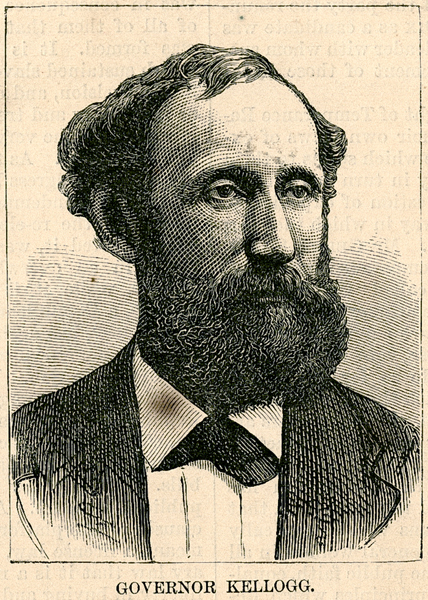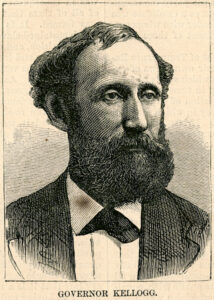William Pitt Kellogg
William Pitt Kellogg was governor of Louisiana during the divisive period of Radical Reconstruction.

Courtesy of The Historic New Orleans Collection
Governor William Pitt Kellogg. Unidentified
William Pitt Kellogg was US senator and governor of Louisiana during the tumultuous Reconstruction era after the Civil War. He was born December 8, 1830, in Orwell, Vermont, to Sherman Kellogg, a minister, and Rebecca Eaton. He attended Norwich Military Academy in Northfield, Vermont. In 1848 the family moved to Peoria County, Illinois, where young Kellogg taught school and read law. He was admitted to the bar in 1853, practiced law in Canton, Illinois, and became a founding member of the state Republican Party. At age thirty he was a delegate to the 1860 Republican convention in Chicago and then a Lincoln presidential elector.
Kellogg served briefly as chief justice of the Nebraska Territory in 1861 (a Lincoln appointment), before returning to Illinois and organizing the 7th Illinois Voluntary Cavalry. He served in the Missouri Campaign of John Pope and earned promotion to brigadier general. Ill health, however, forced him to resign after less than a year of service. In April 1865 President Lincoln appointed him collector of customs in New Orleans, an important patronage position that Lincoln used to promote the growth of a Louisiana Republican party. Before taking up his Louisiana post, Kellogg married Mary Emily Wills of Canton.
In 1868 the first Louisiana legislature under Radical Reconstruction elected Kellogg to the U.S. Senate. He resigned in 1872 to run for governor in what became one of the most fiercely contested and controversial elections of the era. Incumbent Republican Governor Henry Clay Warmoth, who had grown increasingly conservative, conciliating white conservatives and sacrificing the interests of blacks, split the party by supporting Liberal Republican Horace Greeley for president against President Ulysses S. Grant and backing Democrat John D. McEnery for governor. In a bizarre development, the state elections returning board morphed into two rival panels; one proclaimed victory for Kellogg, the other victory for McEnery. For months in the winter and spring of 1873 Louisiana had two governors and two legislatures, each claiming to be the real government. President Grant finally settled the dispute on May 22, recognizing Kellogg as governor.
The bitterly disputed election was an ominous portent. Deeming Kellogg and his party usurpers, Louisiana Democrats mounted one assault after another on Kellogg’s government. On April 13, 1873, Easter Sunday, a mob of whites shot and burned to death more than one hundred black men at Colfax Courthouse in Grant Parish. A month later in New Orleans, Kellogg narrowly escaped assassination when a lone gunman fired a bullet into his carriage, grazing his head. In late August 1874, elements of the Louisiana White League murdered six white Republican officials and four black Republicans in the notorious Coushatta Massacre. Two weeks later in New Orleans, on September 14, thousands of armed White Leaguers clashed with state militia and the Metropolitan Police outside the huge federal Custom House near the foot of Canal Street (dubbed the Battle of Liberty Place by whites). For days afterward Kellogg and hundreds of Republican officials holed up in the Custom House while the White League ruled the city. President Grant intervened in the crisis with federal troops, temporarily banishing the White League and restoring Kellogg to power.
The respite was short-lived. In January 1875, Democrats again attempted to overthrow the state government. Congress investigated this latest coup attempt and worked out the Wheeler Compromise, named for Congressman William A. Wheeler of New York. According to the compromise, Republicans conceded Democratic control of Louisiana’s lower house, and Democrats promised to allow Kellogg to finish out his term. The Wheeler agreement broke down, and in February 1876 the lower house voted impeachment articles against Kellogg, which the Republican Senate cleverly quashed. Only a few weeks later, the Senate leader who had engineered Kellogg’s acquittal was shot six times on the riverbank in Coushatta. Marshall Twitchell miraculously survived, but both of his arms had to be amputated.
Like all southern Republicans of the postwar era, Kellogg’s reputation has been tarnished by decades of racist, anti-Reconstruction propaganda. As a federal army officer posted in Louisiana commented in 1874, “No Republican, whatever his actual character may be . . . could have the reputation of being honest in this state.” Simply because he was a Republican, Kellogg was presumed to be a scoundrel. Ironically, he was an above-average governor. Personally honest, he pressed for railroad construction to modernize the state’s economy, reduced state expenditures, and lowered taxes. Under his leadership, Louisiana was one of the few states in the South to realistically grapple with its massive state debt, most of it the result of prewar and wartime expenditures. The funding act of 1874, a personal project of Kellogg’s, repudiated part of Louisiana’s debt (some of it bogus to begin with) and scaled the total down from $25 million to a more manageable $15 million. Few Louisiana governors could boast as good a record. None of this mattered to his enemies, though. He was a Republican, a northern carpetbagger, and he was elected by Negro votes. That was all most whites needed or cared to know.
In the disputed elections of 1876 and the ensuing Compromise of 1877, Democrats regained control of Louisiana, as well as South Carolina and Florida, the only two states besides Louisiana still under Republican rule. Rutherford B. Hayes became president and ended Reconstruction when he withdrew federal protection from southern Republicans. Before their downfall, though, Republican lawmakers had elected Kellogg to the US Senate. Democrats unsuccessfully contested his election, and he served out his full term. After he left the Senate, the Bayou Teche country elected him to a term in Congress (1883–1885). He moved to Washington, D.C., but remained active in Louisiana and national party politics for another decade. He invested in real estate, and at his death during World War I left an estate valued at more than $300,000. Like Radical Reconstruction, Kellogg, a major figure of the postwar era, was nearly a century ahead of his time.
